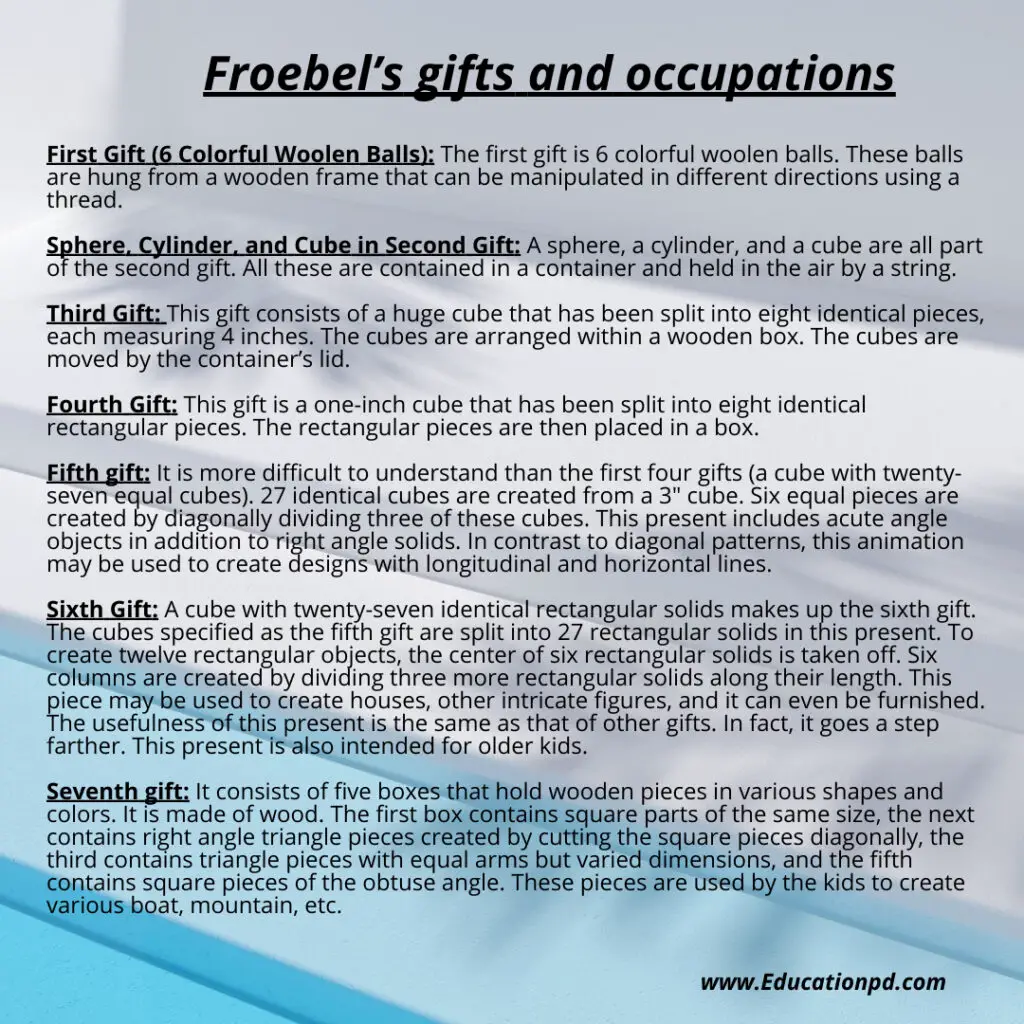Back to: Early Childhood Care and Education B.ed Notes, IGNOU Notes, M.A Notes, Graduation Notes
What was Friedrich Froebel’s theory?
The founder father of kindergartens and a predecessor in the fields of early childhood education and care was Friedrich Froebel (1782–1852). Froebel’s ideas and writings influenced how we see and appreciate formative years. As in the 1850s, Froebel’s theories were seen as groundbreaking, but today’s standard early years teaching approaches are based on the fundamentals of his research.
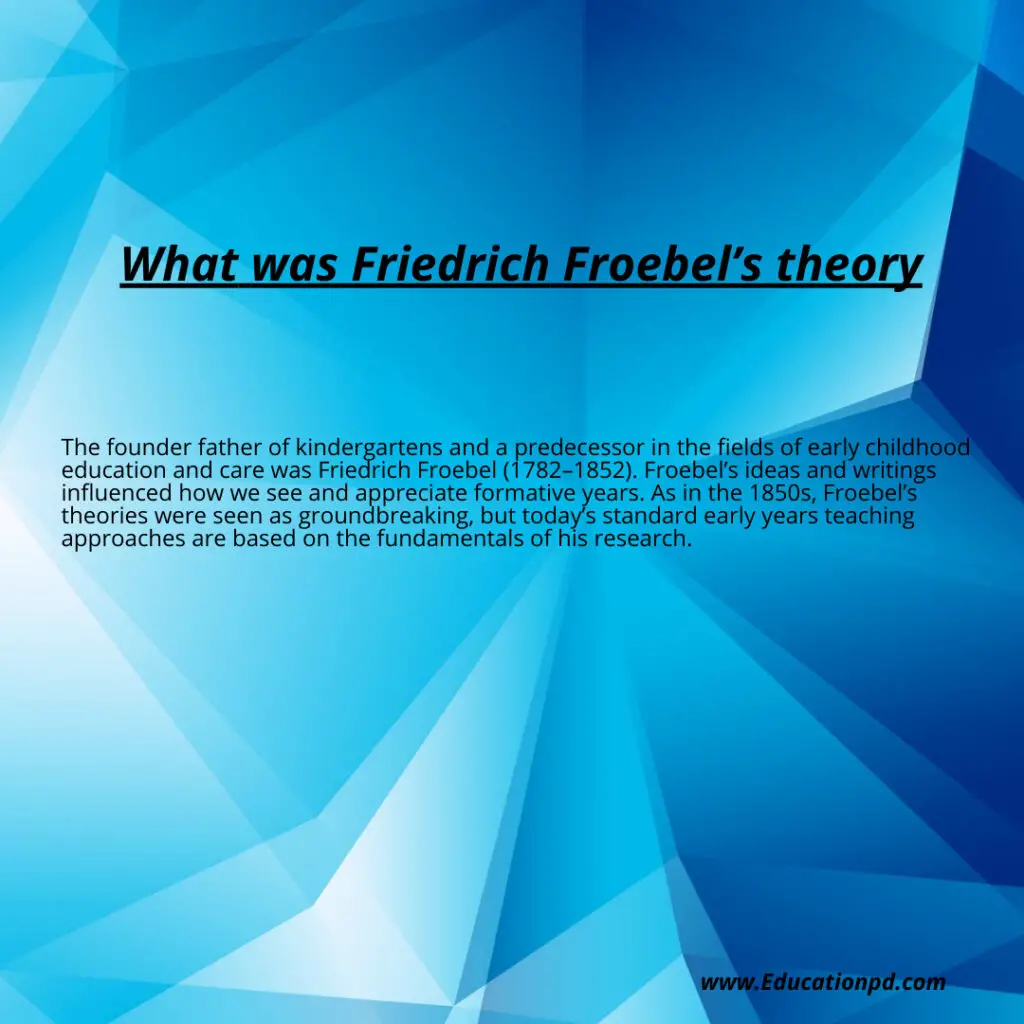
Froebel’s kindergarten principles
- The whole world is interconnected and unified. The greater one’s awareness of themselves, others, their environment, and the larger world, the more one is conscious of this connection. Kids are whole creatures whose emotions, ideas, and deeds are interconnected. Children acquire holistically, so learning must never be divided into separate subjects because everything is connected.
- Every student is special, and the foundation of a child’s learning is what they can accomplish instead of what they cannot. Kids learn when they take initiative and become more conscious of their knowledge. According to Froebelian educators, youngsters are valued for their achievements and respected for who they are. A crucial component of a Froebelian education is assisting students in their reflection.
- Adolescence is more than just a stepping stone to later understanding. Conception is the beginning of learning, which persists throughout life.
- Every child is connected to themselves, their families, caregivers, relatives, and the greater society and is appreciated. A child’s relationships are crucial to their development.
- When children are creative, they express their unique concepts in unique ways with the help of supportive adults and a loving environment. Children communicate their underlying concepts and opinions and create meaning when they start to utilize and create representations. Literal depictions of daily life, society, and civilization evolve through time to become more complex and subtle.
- Playing is a natural element of growing up and enables kids to connect with their inner worlds of emotions, thoughts, and personal experiences. This opens up new horizons for their understanding, experiencing, thinking, and producing, and it will serve as a valuable resource for them in the coming years. Youngsters take pride in the games they play. When it comes to enhancing play as an environment for learning, Froebelian education recognises the role of adults who provide “freedom with guidance.”
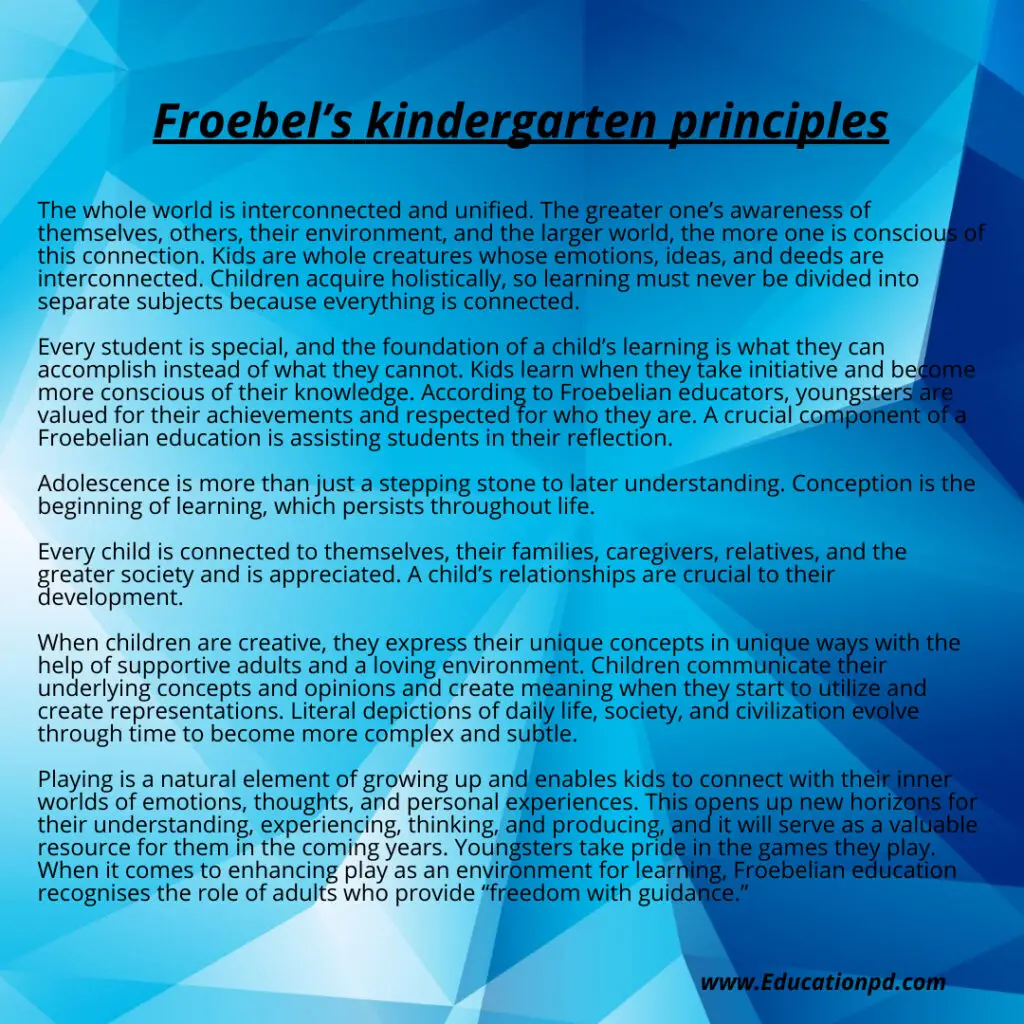
Potential influence of playing:
Friedrich Froebel (1782–1852), a pioneering educator, understood the value of playing when he established the very first preschool for kids under the age of seven in 1836. Froebel thought that playing is the primary way for young kids to develop. Kids develop their knowledge of the world during play by having first hand interactions with it.
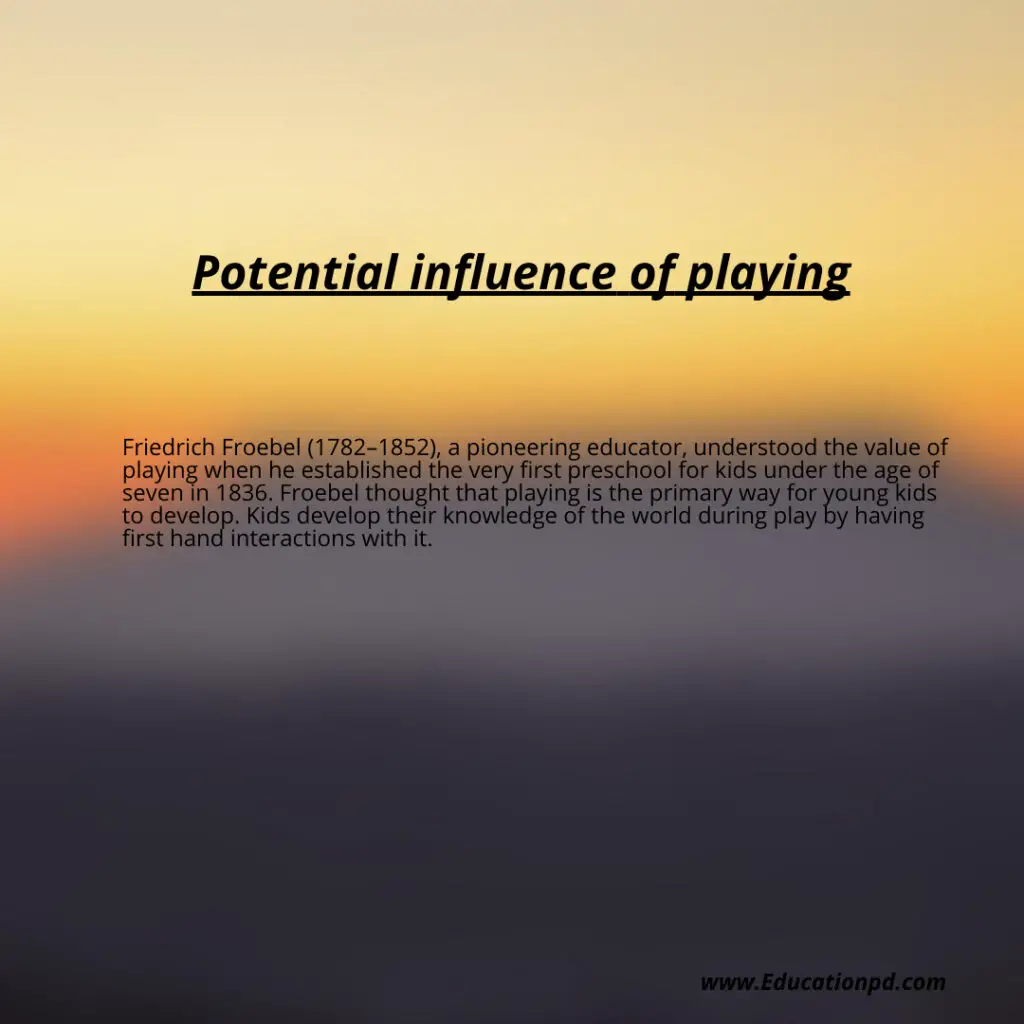
The Concept of Education by Froebel
Froebel observed that the seed has the potential to develop into a full tree; all it needs is access to the ground, oxygen, moisture, and sunshine to do so. He realized that every living thing on the planet is subject to the same rule. According to him, “Education is a process through which a youngster makes its internal outward.” Schooling promotes the development of these inborn human capacities.
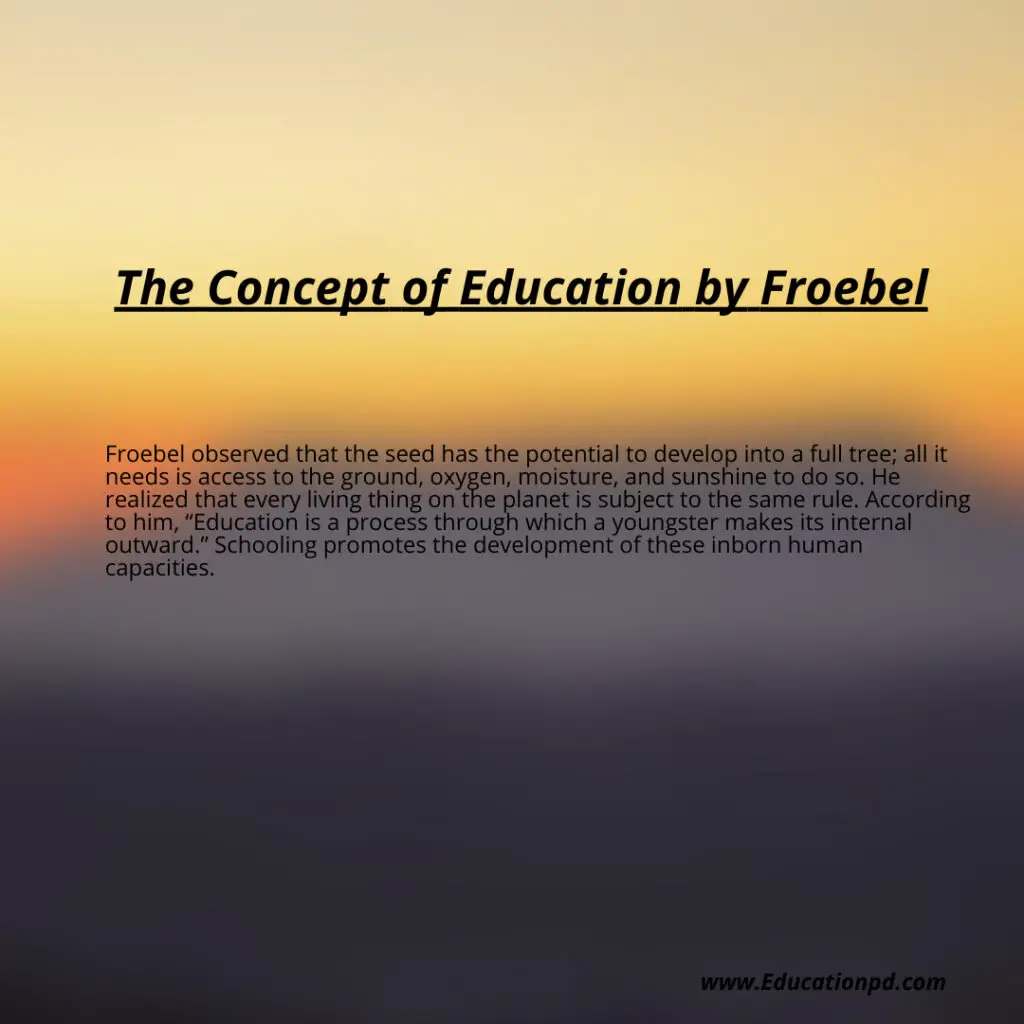
Froebel’s gifts and occupations
Froebel developed 20 gifts or presents with the development of the human senses as a top priority. The most significant of them are the next seven:
- First Gift (6 Colorful Woolen Balls): The first gift is 6 colorful woolen balls. These balls are hung from a wooden frame that can be manipulated in different directions using a thread.
This ability is utilized to spread many kinds of sensory knowledge. The balls’ colors, patterns, and motions train the eyes, their sounds train the hearing, and their touches allow people to feel how hard or soft something is. When played quickly, it does the same and improves the muscles. Actively playing this game with the kids helps them grow as social beings.
- Sphere, Cylinder, and Cube in Second Gift: A sphere, a cylinder, and a cube are all part of the second gift. All these are contained in a container and held in the air by a string.
With the help of this present, kids may become familiar with items of different shapes and learn about their various traits. Additionally, children’s touch power is developed via this gift. This gift provides a framework for comprehending other gifts and how to employ them.
- Third Gift: This gift consists of a huge cube that has been split into eight identical pieces, each measuring 4 inches. The cubes are arranged within a wooden box. The cubes are moved by the container’s lid.
The purpose of this gift is to encourage children’s natural curiosity. With the aid of these eight cubes, the kids create a variety of larger cubes and diverse shapes. In addition to activating them and satisfying their creative needs, it also exercises their senses. Developing varied patterns helps kids develop their creative imagination. The youngster also learns about unity in variety and diversity in unity by experiencing one cube in eight cubes and eight cubes in one cube.
- Fourth Gift: This gift is a one-inch cube that has been split into eight identical rectangular pieces. The rectangular pieces are then placed in a box.
Although slightly more complicated than that, this present is a variation of the third gift. With the assistance of rectangular solids, the kids create more challenging and intricate patterns. Other things that may be made with this gift include tables, chairs, doors, and other kinds of dwellings. With the exception of the change in intensity, this present serves the same purpose as the third gift.
- Fifth gift: It is more difficult to understand than the first four gifts (a cube with twenty-seven equal cubes). 27 identical cubes are created from a 3″ cube. Six equal pieces are created by diagonally dividing three of these cubes. This present includes acute angle objects in addition to right angle solids. In contrast to diagonal patterns, this animation may be used to create designs with longitudinal and horizontal lines.
The capabilities that are acquired by the third and fourth gifts are likewise developed by this gift, but to a different extent. The children’s ability to create new items is developed by this gift. This gift demonstrates variety in togetherness. This present is intended for older kids.
- Sixth Gift: A cube with twenty-seven identical rectangular solids makes up the sixth gift. The cubes specified as the fifth gift are split into 27 rectangular solids in this present. To create twelve rectangular objects, the center of six rectangular solids is taken off. Six columns are created by dividing three more rectangular solids along their length. This piece may be used to create houses, other intricate figures, and it can even be furnished. The usefulness of this present is the same as that of other gifts. In fact, it goes a step farther. This present is also intended for older kids.
- Seventh gift: It consists of five boxes that hold wooden pieces in various shapes and colors. It is made of wood. The first box contains square parts of the same size, the next contains right angle triangle pieces created by cutting the square pieces diagonally, the third contains triangle pieces with equal arms but varied dimensions, and the fifth contains square pieces of the obtuse angle. These pieces are used by the kids to create various boat, mountain, etc. patterns. This present is considerably more intricate.
Froebel also held that parents play a crucial part in their children’s growth and that moms make the finest first instructors. This idea led Froebel’s kindergartens to provide women with a new employment alternative outside the house at a period when there weren’t many choices.
